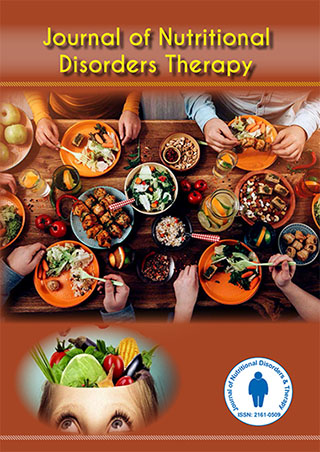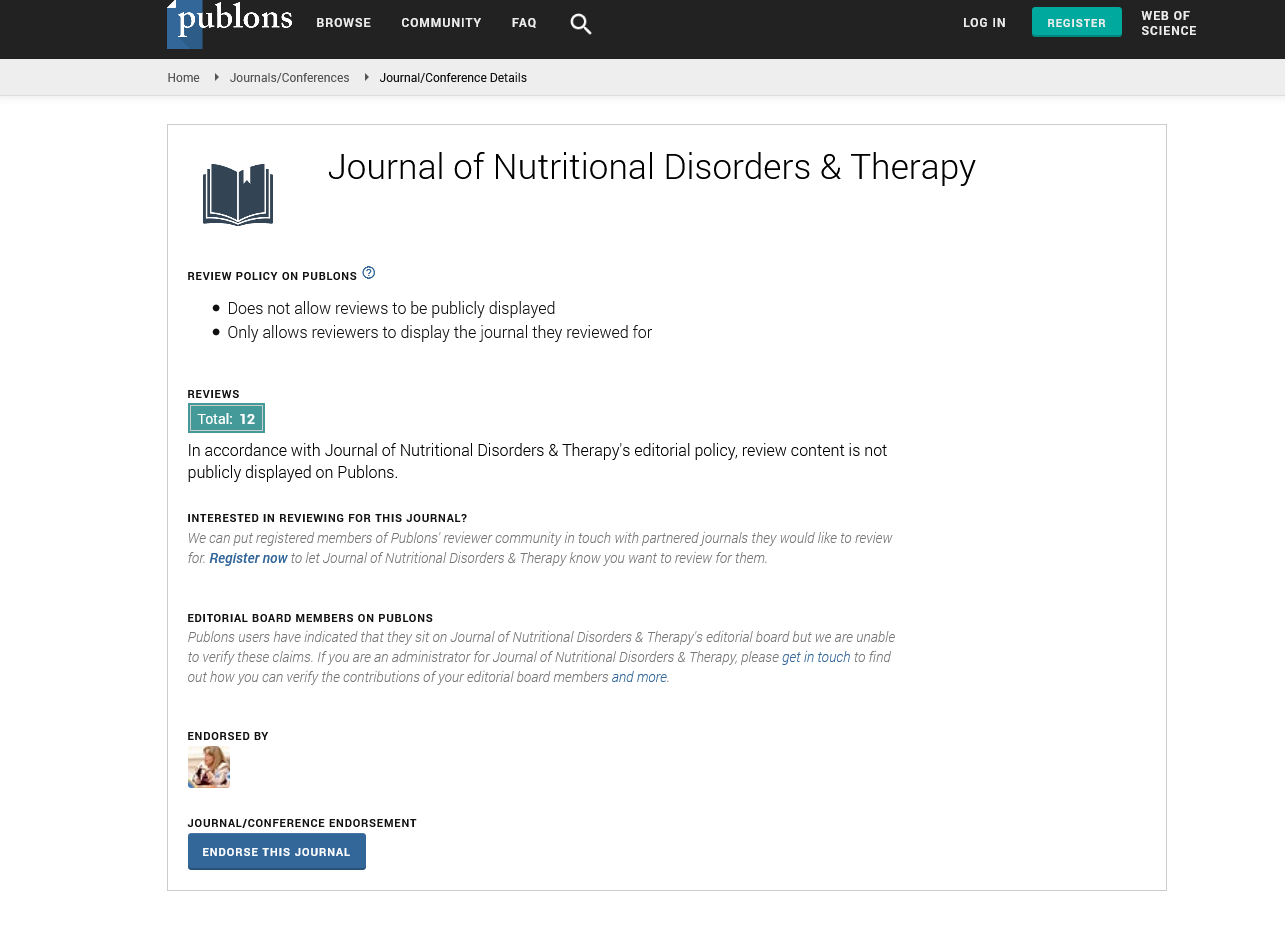Indexed In
- Open J Gate
- Genamics JournalSeek
- Academic Keys
- JournalTOCs
- Ulrich's Periodicals Directory
- RefSeek
- Hamdard University
- EBSCO A-Z
- OCLC- WorldCat
- Publons
- Geneva Foundation for Medical Education and Research
- Euro Pub
Useful Links
Share This Page
Journal Flyer

Open Access Journals
- Agri and Aquaculture
- Biochemistry
- Bioinformatics & Systems Biology
- Business & Management
- Chemistry
- Clinical Sciences
- Engineering
- Food & Nutrition
- General Science
- Genetics & Molecular Biology
- Immunology & Microbiology
- Medical Sciences
- Neuroscience & Psychology
- Nursing & Health Care
- Pharmaceutical Sciences
Commentary Article - (2024) Volume 14, Issue 2
Therapeutic Nutrition for Women's Health: From Menstrual Disorders to Menopause
Emma Pennington*Received: 02-May-2024, Manuscript No. JNDT-24-26218; Editor assigned: 06-May-2024, Pre QC No. JNDT-24-26218(PQ); Reviewed: 20-May-2024, QC No. JNDT-24-26218; Revised: 27-May-2024, Manuscript No. JNDT-24-26218(R); Published: 03-Jun-2024, DOI: 10.35248/2161-0509.24.14.296
Description
Women's health is intricately linked to nutrition, with specific dietary needs changing throughout various life stages. From puberty through menopause, a well-balanced diet is essential in managing and preventing health issues. This article delves into the role of therapeutic nutrition in addressing common women's health concerns, including menstrual disorders, Premenstrual Syndrome (PMS), and menopausal symptoms. Menstrual disorders, such as dysmenorrhea (painful periods), menorrhagia (heavy menstrual bleeding), and amenorrhea (absence of menstruation), can significantly impact a woman's quality of life. Nutritional strategies plays a key role in managing the conditions which were characterized by severe and frequent menstrual cramps and pain. Omega-3 fatty acids, found in fatty fish like salmon and mackerel, and in flaxseeds, have anti-inflammatory properties that can help reduce menstrual pain. Studies have shown that women who consume higher amounts of omega-3 fatty acids report less severe menstrual pain. Magnesium is another nutrient that can help alleviate dysmenorrhea. Found in foods such as spinach, almonds, and avocados, magnesium acts as a muscle relaxant, reducing uterine contractions and easing pain. Additionally, a diet high in magnesium has been associated with a lower incidence of dysmenorrhea. Menorrhagia, or heavy menstrual bleeding, can lead to iron deficiency anemia due to the excessive loss of blood. To counteract this, increasing iron intake through dietary sources such as red meat, poultry, beans, and fortified cereals is essential. Vitamin C-rich foods like oranges, strawberries, and bell peppers enhance iron absorption, making it more effective in combating anemia.
Vitamin K, which plays a key role in blood clotting, can also be beneficial for women with menorrhagia. Green leafy vegetables, such as kale and spinach, are excellent sources of vitamin K. Ensuring an adequate intake of this vitamin can help regulate menstrual flow. Amenorrhea, the absence of menstruation, can result from various factors, including excessive exercise, eating disorders, and hormonal imbalances. Adequate caloric intake and a balanced diet are vital for restoring normal menstrual function. Women with amenorrhea should focus on consuming a variety of nutrient-dense foods, including whole grains, lean proteins, healthy fats, and a wide range of fruits and vegetables. Vitamin D and calcium are also important for women experiencing amenorrhea, particularly if it is linked to low bone density or osteoporosis. Dairy products, fortified plant-based milks, and leafy greens are excellent sources of these nutrients. PMS encompasses a range of symptoms, including mood swings, bloating, and fatigue, that occur in the luteal phase of the menstrual cycle. Nutritional interventions can alleviate these symptoms and improve overall well-being. Calcium and vitamin D can reduce the severity of PMS symptoms. Women who consume higher levels of these nutrients experience fewer mood swings, headaches, and bloating. Dairy products, fortified plantbased milks, and leafy greens are rich sources of calcium, while vitamin D can be obtained from fatty fish, egg yolks, and exposure to sunlight.
Conclusion
Phytoestrogens are plant compounds with estrogenic effects in the body, which can help alleviate menopausal symptoms. Soy products, such as tofu, tempeh, and soy milk, are rich in phytoestrogens and have been shown to reduce the frequency and severity of hot flashes. Flaxseeds and legumes are other good sources of these compounds. The decline in estrogen levels during menopause can lead to decreased bone density, increasing the risk of osteoporosis. Sufficient intake of calcium and vitamin D is potential for maintaining bone health. Dairy products, fortified plant-based milks, and leafy greens provide calcium, while vitamin D can be sourced from fatty fish, egg yolks, and sunlight. Omega-3 fatty acids can help manage menopausal symptoms, particularly mood swings and depression. Fatty fish, flaxseeds, and chia seeds are rich sources of omega-3s. Incorporating these foods into the diet can support mental health and reduce inflammation. Antioxidants play a role in reducing oxidative stress and inflammation, which are linked to many menopausal symptoms. Berries, nuts, and vegetables are rich in antioxidants and should be included in a balanced diet. These nutrients can help protect against chronic diseases and support overall health during menopause.
Citation: Pennington E (2024) Therapeutic Nutrition for Women's Health: From Menstrual Disorders to Menopause. J Nutr Disord Ther. 14:296.
Copyright: © 2024 Pennington E. This is an open-access article distributed under the terms of the Creative Commons Attribution License, which permits unrestricted use, distribution, and reproduction in any medium, provided the original author and source are credited.

